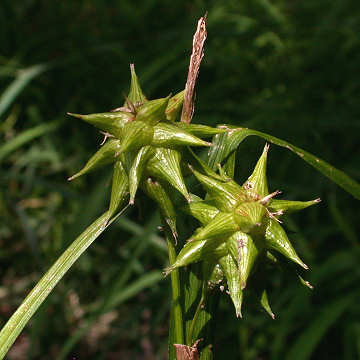

Carex grayi - (image 1 of 2)
Taxonomy
Family: Cyperaceae
Habitat
Moist woods, upland swamps, alluvial terraces, backwaters.
Associates
Distribution
MA, VT, southern Quebec and southern Ontario, west to WI and southeast MN, south to GA and MO.
Morphology
Perennial to 0.9 m. Stems solitary or in small clusters, purplish at the base, rough-margined. Leaves and leaf sheaths septate-nodulose; leaves 5-8 mm wide, rough-margined, glabrous or scabrous; front of sheath with a whitish band with a brown, concave summit; ligule rounded. Bracts exceeding the inflorescence; spikelets globose, about 3 cm in diameter; perigynia 11-18 mm long, ribbed, inflated, pubescent or scabrous, the beak wedge-tapered; scales sometimes awned with rounded to pointed tips, shorter than the perigynia; stigmas 3. Achenes trigonous; style slightly curved, persistent.
Notes
Fruiting June to August
Wetland indicator: FACW
This species is similar to C. intumescens Rudge. Two other species, C. lupuliformis and C. lupulina also have inflated perigynia over 10 mm long but are more thin-tapered.
References
Curtis, L. 2006. Woodland Carex of the upper Midwest. Lake Villa, IL.
Gleason, Henry A. and A. Cronquist. 1991. Manual of Vascular Plants of
Northeastern United States and Adjacent Canada. Second Ed.
The New York Botanical Garden. Bronx, NY
Swink, F. and G. Wilhelm. 1994. Plants of the Chicago Region.
Indiana Academy of Science. The Morton Arboretum. Lisle, Illinois.
|
© Michael Hough 2009 |